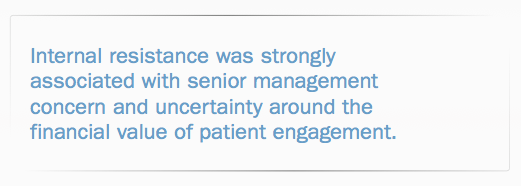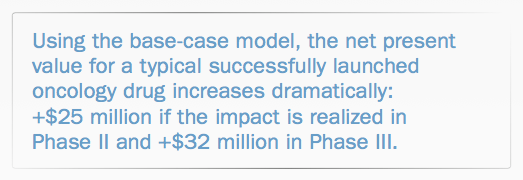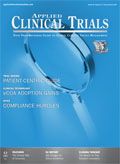Measuring Adoption and Value of Patient Engagement
Applied Clinical Trials
Recent studies may help break down barriers to implementing patient-centric initiatives.
The adoption of select patient engagement initiatives is making steady progress but not without encountering substantial headwinds.
According to a 2016 CenterWatch survey of 95 major and mid-sized pharmaceutical companies, nearly two-thirds of sponsors report that they are facing pushback on implementation. Survey respondents identified three primary challenges: 57% reported
Ken Getz

internal resistance to modifying current drug development practices and processes; 40% noted the lack of internal expertise required to manage adoption; and 35% reported that there was insufficient funding to cover the investment required.
Although the virtues of patient engagement are profoundly obvious to many, according to that same survey, internal resistance was strongly associated with senior management concern and uncertainty around the financial value of patient engagement. Two recently completed studies-one a retrospective assessment and the other a prospective modeling exercise-should help inform senior management about the financial return on patient engagement.
Retrospective assessment
Throughout 2016, the Drug Information Association (DIA)-in collaboration with the Tufts Center for the Study of Drug Development (Tufts CSDD)-met with 22 pharmaceutical companies and contract research organizations (CROs) to gather baseline data on patient engagement practices and their impact. The study also looked at guidelines and frameworks designed to assist implementation planning. The results of this study are being presented at conferences and webinars and can be accessed on the DIA website.
The working group conducted surveys and interviews, collected case studies of actual patient engagement initiatives and reviewed the published peer-reviewed and trade literature. The most widely adopted engagement initiatives among the working group

companies involved soliciting input from patients and professionals to inform protocol design feasibility, clinical trial positioning and implementation. Seventeen of the 22 companies reported routinely implementing and piloting patient advisory boards. Sixteen companies reported implementing and piloting advisory panels with investigative site staff and health care providers.
Thirteen of 22 organizations reported that they are routinely implementing and piloting the distribution of non-technical plain language clinical trial results summaries to their clincial study volunteers.
Other more commonly adopted initiatives include the use of home nursing networks (9 out of 22); the conduct of surveys among study volunteers during and after clinical trials (9 out of 22) and the use of wearable devices (8 out of 22). Seven companies reported piloting, and 11 companies indicated that they are planning to use electronic informed consent.
The working group observed a wide variety of organizational models used to manage patient engagement initiatives. The most prevalent model was a dedicated and centralized function with the following primary responsibilities:
- Facilitate cultural change within the organization
- Build policies, guidelines, processes and tools
- Share effective practices across the company
- Advance more systematic patient-centric practices company-wide
- Facilitate and coordinate implementation
- Manage internal alignment of patient engagement and advocacy outreach efforts
In total, 121 case examples of patient-centric initiatives were gathered and analyzed. These case examples produced 650 metrics in total, of which 260 were quantitative in nature.
The working group was unable to aggregate the quantitative metrics across the case studies to derive average impact measures and to make meaningful comparisons.
At this time, companies have neither defined nor collected metrics uniformly.
Patient and professional advisory boards, social media engagement and patient education programs were among those offering the highest return on engagement. These initiatives required minimal investment, were relatively easy to implement and had a significant reported impact, including faster study planning, approval and initiation time lines; higher randomization, recruitment and retention rates; fewer disruptions and delays; and more positive study volunteer satisfaction levels.
Wearable devices, home nursing networks and telemedicine generally provided a strong but relatively lower return on engagement, as they required larger upfront investment and more substantial technical and operating support to implement. Impact measures showed improvements in enrollment and retention rates.
The DIA website provides a detailed summary of 12 patient engagement initiative categories for which case-example metrics were gathered. The website also provides a Return on Engagement Toolkit for sponsor companies to apply to measure the impact of their own initiatives.
Prospective valuation modeling
The Clinical Trials Transformation Initiative (CTTI) funded a project in 2016 to model the value proposition of patient engagement. Project members included representatives from several pharmaceutical companies, Duke University and Tufts CSDD, and CTTI. The aim of this study was to apply a widely accepted financial modeling method commonly used by high-risk, R&D-intensive industries to guide portfolio planning and investment.
The model components include factors that drive project value or net return- such as the revenue generated following a successful commercial launch; the direct and indirect total development and commercialization costs; the cumulative development cycle time duration; and the probability of success due to technical and regulatory risk.
The CTTI team developed base-case models of typical Phase II and Phase III oncology development programs using benchmark cycle time, cost and risk data gathered, maintained and published by Tufts CSDD. The model outputs included both net present value (NPV) and expected net present value (ENPV) estimates. The former is defined as the after-tax, inflation-adjusted present value of incoming and outgoing cash flows, assuming regulatory approval and market launch.
NPV estimates vary depending on the outcome of clinical trials at each phase of development and the risk that each potential outcome represents. ENPV combines all of the individual NPV estimates to derive an average, aggregated, risk-adjusted measure.
Base-case NPV and ENPV measures were compared to those following adjustments to the model. Patient-centric initiatives are expected to improve the relevance and executional feasibility of study protocols and to enhance the study volunteer experience. The CTTI team assumed that select patient-centric initiatives (e.g., patient and professional advisory panels) may result in the avoidance of one Phase II or Phase III protocol amendment.
On average, according to a 2016 Tufts CSDD study, a single amendment adds 90 days to the development timeline and requires $141,000 and $535,000 in direct Phase II and III costs, respectively, to implement.
Using the base-case model, and assuming that a modest $50,000 expenditure to implement a patient engagement initiative will result in one less Phase II and III protocol amendment, the NPV for a typical successfully launched oncology drug increases dramatically: +$25 million if the impact is realized in Phase II and +$32 million in Phase III. The ENPV also increases substantially (+$15 million) when the protocol

amendment is avoided in Phase III.
The ENPV increase in Phase II is more modest-+$4 million-since the measure penalizes earlier stage projects that will encounter later stage risk. Still, in all cases, a modest investment in a given patient engagement initiative that leads to the avoidance of a protocol amendment will yield a return on that investment many magnitudes greater.
The CTTI team also tested the prospective NPV and ENPV impact on patient engagement initiatives driving faster recruitment rates and higher retention rates. The results again indicate very high increases in NPV and ENPV based on modest investments. It’s important to note that the model is not measuring the strategic value of patient engagement initiatives-such as improvements in relationships with patient communities and better long-term positioning within a given market.
The results of this prospective valuation model will soon be published in a peer-review journal. Refer to the CTTI website (https://www.ctti-clinicaltrials.org) to find this paper among a listing of papers published there.
Removing headwinds
For the majority of biopharmaceutical companies and CROs, patient engagement practices are in their early stages. The retrospective assessment provides initial baseline adoption data, resources, insights and case study-based impact measures. The prospective assessment offers a financial modeling framework that sponsors can systematically apply and test to inform their decisions to invest in and support patient engagement initiatives. Combined, these two studies may help alleviate the headwinds that many organizations are encountering.
Ken Getz, MBA, is the Director of Sponsored Research at the Tufts CSDD and Chairman of CISCRP, both based in Boston, MA. email: kenneth.getz@tufts.edu
